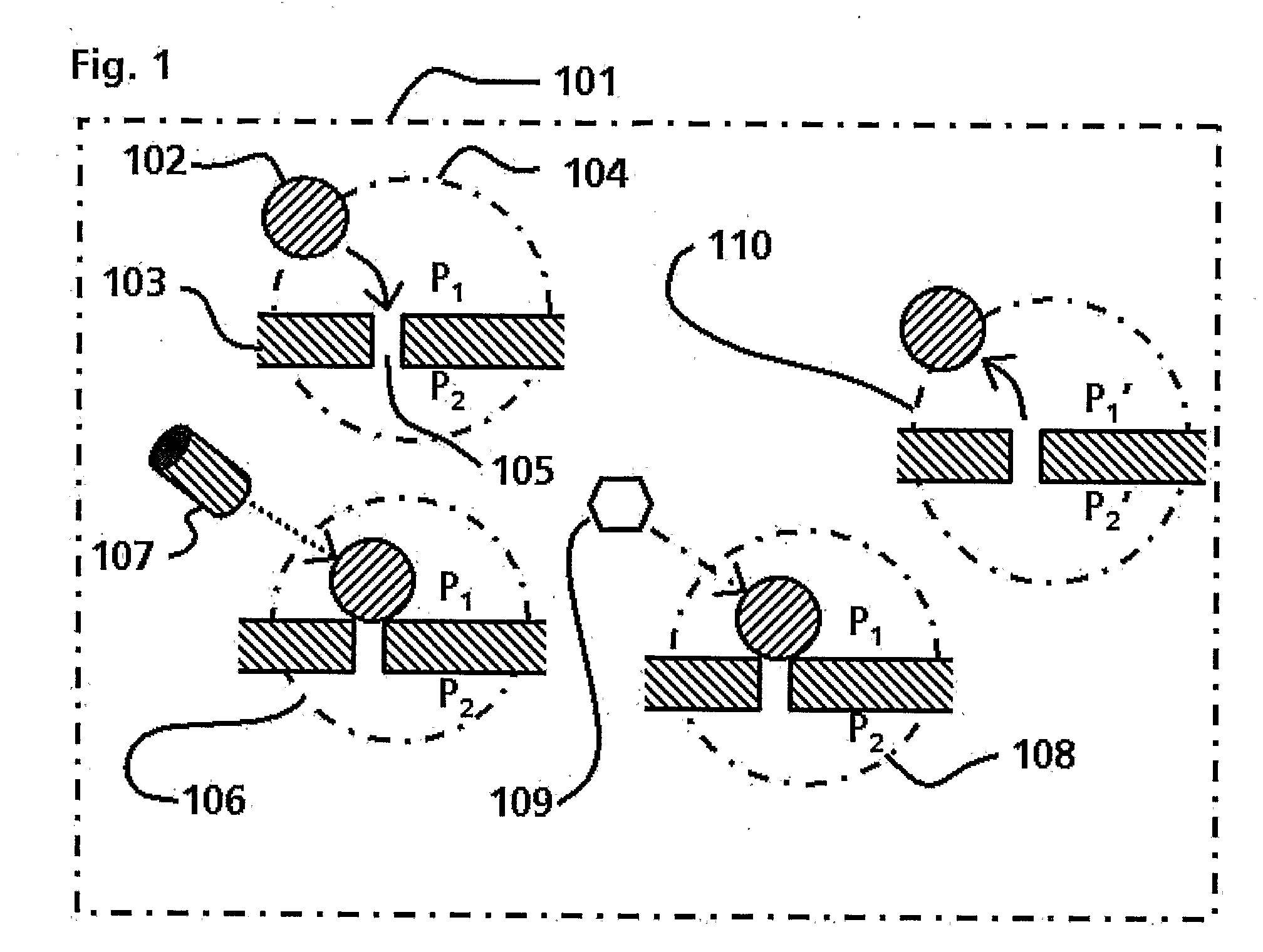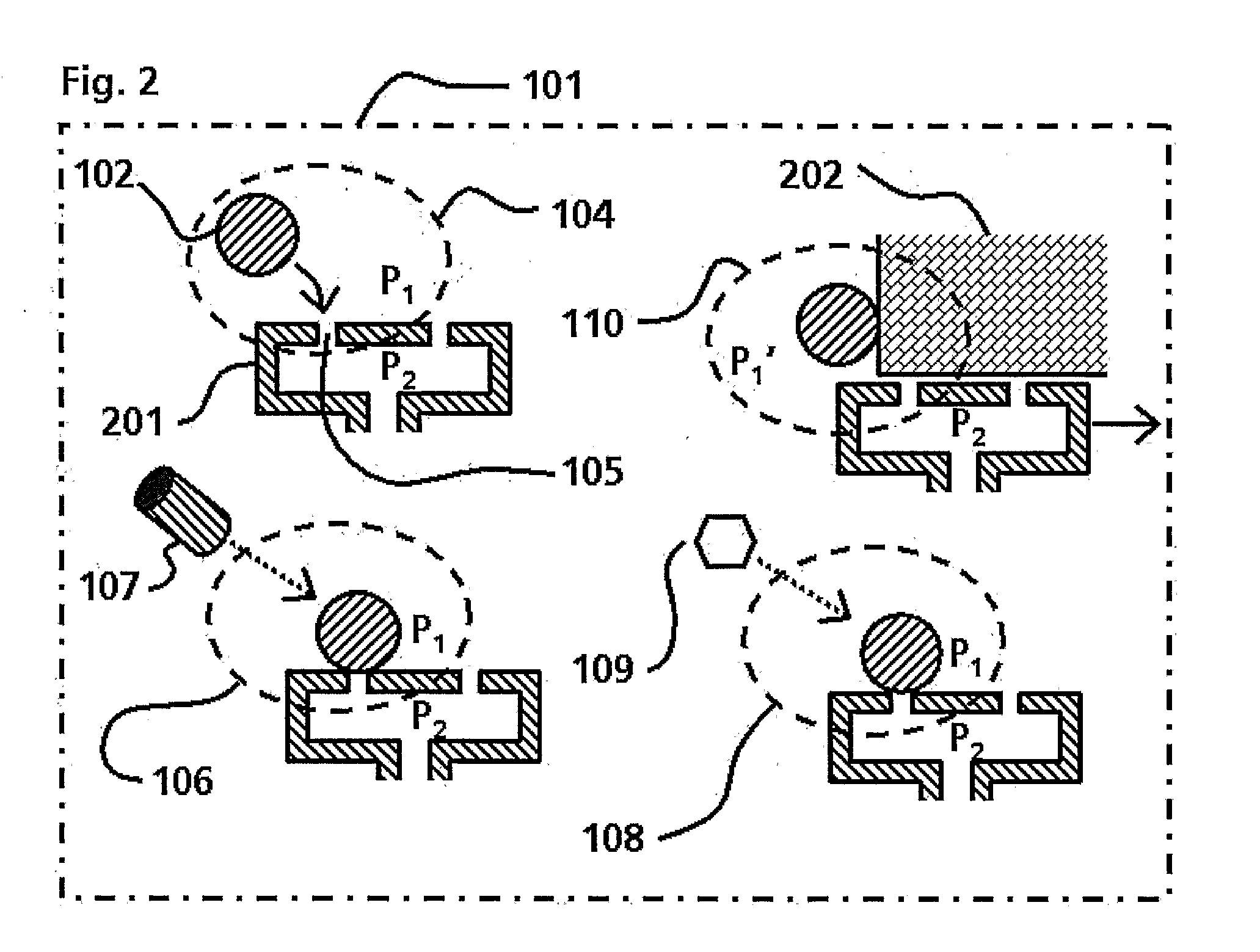Spherical encoded beads
a technology of encoded beads and spherical beads, which is applied in the field of compositions comprising spherical beads, can solve the problems of irregular shape of synthesis members, unsuitable high-throughput handling, and lack of methods to ensure the synthesis of spherical beads, and achieves the effects of reducing the number of synthesis members, reducing the number of synthesis steps, and prolonging the reading tim
- Summary
- Abstract
- Description
- Claims
- Application Information
AI Technical Summary
Benefits of technology
Problems solved by technology
Method used
Image
Examples
example 1
Handling and Detection of Radiofrequency Encoded Polymer Beads
[0388]A bead analysis apparatus with auxiliaries for controlling the bead handling is constructed comprising (numbers referring FIG. 7):
a rotating vacuum container comprising:[0389]a 100 mm diameter POM capture disc with 100 equidistant 0.2 mm diameter capture holes, arranged along an 80 mm diameter circular track running 10 mm from the edge of the capture disc, the capture disc being positioned with its planar surfaces vertical,[0390]a 100 mm outer diameter POM capture disc holder for holding the capture disc and for containing the vacuum inside the vacuum container, and[0391]a 5 mm outer diameter and 3 mm inner diameter stainless steel shaft with a hole therein for applying a vacuum,
a vacuum container housing comprising:[0392]a stainless steel cylinder (306) of inner diameter 10.2 mm surrounding the vacuum container,[0393]a stainless steel circular back plate with a central through-going hole therein for connecting the ...
example 2
Upscaled Handling and Identification of Radiofrequency Encoded Polymer Beads
[0416]The bead handling apparatus and auxiliaries described in Example 1 were operated with the following operation parameters:
[0417]The first gear pump was running at 2500 rpm.
[0418]The second gear pump was running at 40% of maximum rotational speed.
[0419]The pulse generator was running in continuous single pulse mode with 0.25 seconds between pulses and a pulse width 0.5 milliseconds.
[0420]The bead feeding syringe was mounted on a syringe pump set to run in continuous withdrawal / infusion mode with volume setting 0.1 mL and rate setting 1.0 mL / min. It was noted that the actual volume of infused bead dispersion per withdrawal / infusion cycle was substantially less than the nominal value of 0.1 mL due to the combined mechanical bias of the syringe mounting and of the flexible plastic syringe itself.
[0421]The operation of the bead handling apparatus described above results in a portion of the beads being transp...
example 3
Total-Fluorescence-Based Bead Sorting
[0423]In order to develop novel ligands for use in chromatographic purification of proteins, a ligand library is prepared by the following method:
Compound Synthesis
[0424]200,000 PEGA-type polymer beads with diameters in the range 0.5-0.7 mm are subjected to a four step solid phase split-process-recombine combinatorial synthesis route involving ten different building blocks per step, whereby approximately 10,000 compounds, here ligands, are generated, each bead carrying one ligand, and each ligand being carried by 20 beads on the average.
[0425]In order to evaluate the affinity of the ligands towards a specific protein, the beads are exposed to an aqueous solution of a fluorescence labelled modification of the protein and subsequently weakly adhering fluorescence labelled protein is removed by washing. Now the beads that carry a ligand with high affinity towards the fluorescence labelled protein are strongly fluorescent, whereas beads carrying low ...
PUM
| Property | Measurement | Unit |
|---|---|---|
| Angle | aaaaa | aaaaa |
| Frequency | aaaaa | aaaaa |
| Composition | aaaaa | aaaaa |
Abstract
Description
Claims
Application Information
 Login to View More
Login to View More - R&D
- Intellectual Property
- Life Sciences
- Materials
- Tech Scout
- Unparalleled Data Quality
- Higher Quality Content
- 60% Fewer Hallucinations
Browse by: Latest US Patents, China's latest patents, Technical Efficacy Thesaurus, Application Domain, Technology Topic, Popular Technical Reports.
© 2025 PatSnap. All rights reserved.Legal|Privacy policy|Modern Slavery Act Transparency Statement|Sitemap|About US| Contact US: help@patsnap.com



